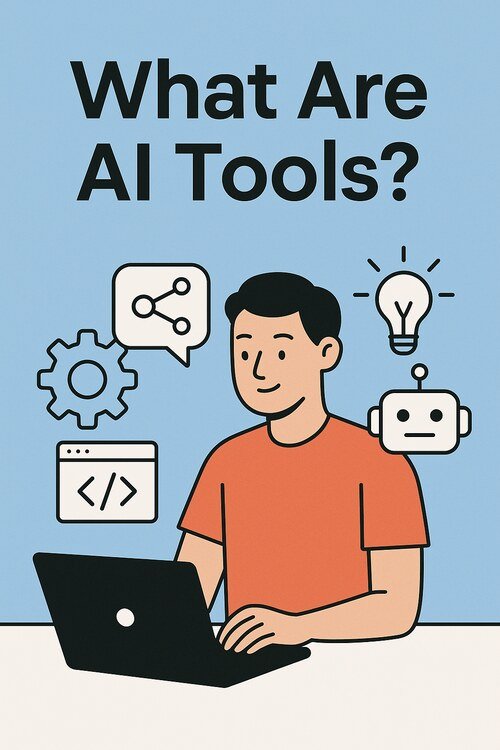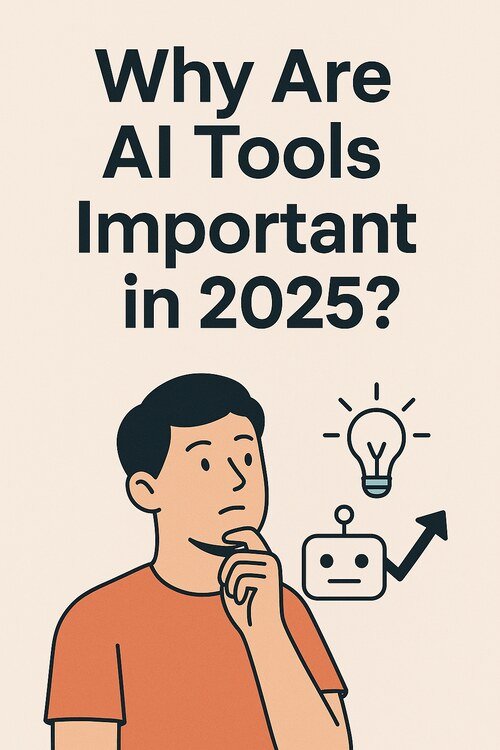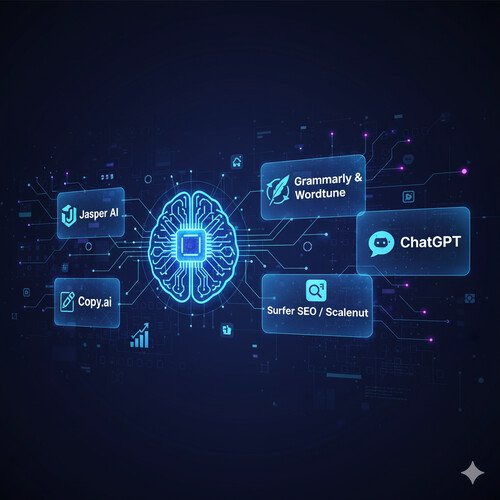Quick Summary Table of AI Tools
| Category | Main Function | Popular Tools | Best For |
| Writing & Content Creation | Blog writing, SEO content, editing | Jasper, Copy.ai, Grammarly, ChatGPT, Grok | Bloggers, marketers, students |
| Image & Design | AI-generated art, branding, photo editing | MidJourney, Canva AI, DALL·E, ChatGPT, Gemini, Grok | Designers, brands, creators |
| Video Creation | AI video generation & editing | Hailuo ai, Kling, Veo 3, Google AI studio, Sora 2, Meta AI, Runway, Synthesia, Pika Labs | YouTubers, businesses, educators |
| Audio & Music | Voiceovers, podcast editing, AI music | ElevenLabs, Soundraw, Adobe Podcast | Musicians, podcasters, creators |
| Chatbots & Assistants | Customer support, personal AI companions | ChatGPT, Claude, Pi AI | Businesses, students, individuals |
| Productivity | Notes, task management, automation | Notion AI, Otter.ai, Motion | Startups, enterprises, freelancers |
| Marketing & SEO | Keyword research, content optimization, AI ads | Surfer, Clearscope, AdCreative.ai | Digital marketers, agencies |
| Coding & Dev Tools | Code generation, debugging, testing | GitHub Copilot, Tabnine, Replit | Developers, startups |
|
Business Intelligence |
Analytics, dashboards, predictions | Tableau AI, DataRobot, Akkio | Analysts, enterprises |
|
Industry-Specific |
Education, healthcare, law, HR | Gradescope, PathAI, Harvey AI | Specialized professionals |
|
Security & Ethics |
Fraud detection, bias & privacy tools | Darktrace, Fairlearn, Gretel.ai | Security teams, compliance |
Introduction
Artificial Intelligence has gone from being a futuristic concept to an everyday companion. AI tools are no longer optional, they are now essential for businesses, creators, students, and even everyday personal use. For example, I can’t even imagine writing a simple email now without getting it refined by my favorite free version of ChatGPT.
Consider this: in 2015, only a handful of companies used AI-driven solutions. Fast forward to today, and AI tools generate marketing campaigns, write movie scripts, compose music, analyze financial data, and even assist doctors in detecting diseases. The global AI market is projected to reach $407 billion by 2027 (Statista), and much of that growth is fueled by the widespread adoption of AI tools across industries.
In this guide, we’ll cover:
- What AI tools are and how they evolved
- Why they matter in 2025
- The 11 main categories of AI tools with real-world examples
- Free vs Paid AI tools (and when to upgrade)
- How to choose the right AI tool for your needs
- Future trends shaping AI’s role in work and life
(Suggested image: A futuristic workspace where different AI apps (writing, design, video, coding) float as holograms around a user)
What Are AI Tools?

At the simplest level, AI tools are applications powered by machine learning and artificial intelligence algorithms that help users perform tasks better, faster, and often more creatively than traditional software.
Unlike regular software, which follows pre-set rules, AI tools learn from data, adapt to user input, and improve with usage. For example:
- Grammarly doesn’t just flag spelling mistakes — it learns your tone and suggests better phrasing.
- MidJourney doesn’t just generate random images — it creates tailored visuals based on your prompt history.
- GitHub Copilot doesn’t just autocomplete — it suggests entire blocks of code, refined by millions of coding patterns.
Evolution of AI Tools (2015–2025):
- 2015–2017: Early chatbots & simple recommendation engines
- 2018–2020: Rise of deep learning in text and image recognition
- 2021–2022: First mainstream AI writers & image generators (GPT-3, DALL·E, Jasper, Canva AI)
- 2023–2024: Explosion of multimodal AI tools (Runway for video, ElevenLabs for audio, MidJourney for art)
- 2025: Convergence into all-in-one ecosystems (Notion AI, ChatGPT plugins, Google Workspace AI assistants)
(Suggested image: Timeline graphic showing AI tools evolution from 2015 → 2025)
Why Are AI Tools Important in 2025?

AI tools are important for three main reasons: productivity, creativity, and competitiveness.
- Productivity Gains:
A survey by PwC found that 67% of businesses using AI report significant time savings. For example, Otter.ai automatically transcribes meetings, allowing teams to focus on collaboration instead of note-taking. - Creative Enhancement:
Writers, designers, and musicians are no longer constrained by blank pages. Jasper can draft blog posts in minutes, while Suno.com composes background music with a click. AI enhances creativity by generating starting points that humans refine. - Business Competitiveness:
From startups to Fortune 500 companies, AI adoption is becoming a survival factor. AI chatbots save millions in customer service costs, while AI analytics tools like Akkio spot patterns that humans might miss. - Accessibility:
Free AI tools (like Canva AI, ChatGPT’s free tier, Grammarly. Gemini, Grok) lower the entry barrier, enabling students and freelancers to benefit from the same tech as big corporations.
(Suggested visual: Bar chart comparing productivity % increase in companies using AI tools vs those not using AI)
Categories of AI Tools
This is where the ecosystem really shines. Let’s dive into the 11 main categories of AI tools with detailed breakdowns.
1. AI Writing & Content Creation Tools

These tools generate articles, marketing copy, scripts, and more. They use natural language processing (NLP) models trained on billions of texts.
Examples:
- Jasper AI – Marketing-focused writing assistant with templates.
- Copy.ai – Simplifies ad copy and short-form content.
- Grammarly & Wordtune – Advanced grammar, tone, and rewriting tools.
- Surfer SEO / Scalenut – Combine AI writing with search optimization.
- ChatGPT – In my opinion, this single AI tool is an all-rounder. It can write, create images, and now even generate videos with sound, like VEO 3.”
Use Cases:
- Content marketers scaling blog output
- Students drafting essays
- Businesses writing ad campaigns
(Suggested table: Comparison of Jasper vs Copy.ai vs Writesonic with features, pricing, pros & cons)
2. AI Image Generation & Design Tools
These tools transform text prompts into images, illustrations, and designs.
Examples:
- ChatGPT – Logo and Cover Pictures Design, Hyper-realistic Images, Ad images for products
- Grok – Realistic images, Cartoon style, and Great images for a visual story channel.
- Gemini – I love this tool, I can add/remove a person from any image without changing face.
- MidJourney – Artistic, high-quality AI images.
- DALL·E 3 – More literal, prompt-accurate generation.
- Canva AI – Mainstream design tool with AI integrations.
- Looka / Brandmark – Logo and brand identity creators.
Use Cases:
- Social media creators designing posts
- Startups making logos
- Artists experimenting with digital art
(Suggested visual: Side-by-side AI-generated images from MidJourney vs DALL·E)
3. AI Video Creation & Editing Tools

AI video tools can turn text into video, auto-edit clips, or generate avatars.
Examples:
- Runway – AI video editing, scene generation, green screen removal.
- Pika Labs – Text-to-video animation.
- Synthesia – AI-generated avatars for business training videos.
- OpusClip – Auto-clips long videos into social shorts.
- Google Veo3 – Text to a Video with different characters, audio, sound effects and bgm.
- Sora 2 – Video, Dialogues, Background Sound and Different Scenes
Use Cases:
- YouTubers creating faster edits
- Businesses producing explainer videos
- Educators making course content
(Suggested infographic: Workflow diagram from text → video → social media snippets)
4. AI Audio & Music Tools
From AI voiceovers to AI-composed music, audio creation has been revolutionized.
Examples:
- ElevenLabs – Ultra-realistic voice generation.
- AIVA – AI music composer for film/game scores.
- Adobe Podcast – Noise removal + voice enhancement.
- Krisp – Background noise suppression.
Use Cases:
- Podcasters cleaning audio
- Musicians generating background tracks
- Advertisers making quick voiceovers
5. AI Chatbots & Virtual Assistants
Conversational AI is at the heart of modern productivity and customer support.
Examples:
- ChatGPT – General-purpose conversational AI.
- Claude AI – Safe, reasoning-focused chatbot.
- Pi AI – Friendly, personal AI assistant.
- Intercom / Drift – Business-focused customer service chatbots.
Use Cases:
- Customer support automation
- Students using AI tutors
- Professionals managing schedules
6. AI Productivity & Business Tools
These tools boost workflow efficiency.
Examples:
- Notion AI – Writing + productivity inside Notion.
- Otter.ai – Meeting notes & summaries.
- Motion – AI scheduling & task automation.
- Gamma – AI presentation creator.
Use Cases:
- Teams automating project workflows
- Freelancers managing multiple clients
- Executives needing better meeting records
7. AI Marketing & SEO Tools
SEO and marketing are some of the fastest-growing AI categories.
Examples:
- Surfer SEO – Content optimization.
- Frase / Clearscope – Keyword & topic clustering.
- AdCreative.ai – AI-generated ad banners.
- Lately.ai – Repurposes blogs into social posts.
Use Cases:
- Agencies producing scalable campaigns
- Bloggers ranking faster in Google
- Brands optimizing ad spend
8. AI Coding & Developer Tools
AI tools have become co-pilots for programmers.
Examples:
- GitHub Copilot – Autocompletes & suggests code.
- Tabnine – AI-powered code completion.
- Replit Ghostwriter – Browser-based AI coding.
- Testim / Mabl – Automated software testing.
Use Cases:
- Developers coding faster
- Startups launching MVPs quickly
- QA teams automating testing
9. AI Business Intelligence & Analytics Tools
These tools analyze data and predict trends.
Examples:
- Tableau AI – Smart data dashboards.
- DataRobot – Automated machine learning for businesses.
- Akkio – AI analytics for non-technical teams.
Use Cases:
- Business leaders making data-driven decisions
- Analysts predicting trends
- Startups using AI without data science teams
10. AI Tools in Specialized Industries
- Healthcare: PathAI (disease detection), Watson Health
- Education: Quizgecko (quizzes), Gradescope (grading)
- Legal: Harvey AI, Casetext
- HR: HireVue (interviews), Pymetrics (candidate evaluation)
- Real Estate: Restb.ai (property image analysis)
(Suggested visual: Sector-based infographic — AI in healthcare, education, law, HR, real estate)
11. AI Security & Ethics Tools
Security & compliance are critical as AI expands.
Examples:
- Darktrace – AI cybersecurity.
- Kount AI / Sift – Fraud detection.
- Fairlearn / Aequitas – AI bias detection.
- Gretel.ai / MostlyAI – Privacy-focused data anonymization.
Use Cases:
- Banks preventing fraud
- Enterprises monitoring AI ethics
- Developers ensuring fairness
Free vs Paid AI Tools
| Feature | Free AI Tools | Paid AI Tools |
| Cost | Free or freemium | Subscription-based |
| Features | Limited | Advanced, integrations |
| Support | Minimal | Dedicated support |
| Best For | Beginners, students | Professionals, enterprises |
How to Choose the Right AI Tool
- Define your purpose → writing, design, analytics, productivity.
- Evaluate integrations → does it connect with Google Docs, Slack, Notion?
- Compare pricing → free vs paid tiers.
- Test usability → user experience matters.
- Check scalability → does it grow with your needs?
The Future of AI Tools
The next wave of AI tools will be:
- Multimodal – handling text, video, and audio in one app.
- More personal – learning your style and adapting.
- Regulated – with stronger compliance and ethical standards.
- Collaborative – humans + AI creating together, not competing.
Conclusion
AI tools in 2025 are not just software — they’re co-creators, problem-solvers, and accelerators of human potential. Whether you’re a marketer, developer, teacher, or freelancer, the right AI tool can save you time and unlock new creative possibilities.
Explore the categories above, dive into detailed reviews, and experiment with tools that fit your workflow. The future isn’t AI vs humans — it’s AI + humans.
FAQs
- What are AI tools used for?
AI tools are used for content creation, design, video, coding, analytics, productivity, and industry-specific tasks like healthcare or law. - Which AI tools are best for beginners?
Free tools like Canva AI, Grammarly, ChatGPT (free plan), and Notion AI are excellent for beginners. - Are free AI tools enough?
Yes, for simple needs. But for professional workflows, paid tools often deliver better integrations and results. - Which industries benefit most from AI tools?
Marketing, healthcare, education, law, and software development are leading adopters in 2025. - What is the future of AI tools?
Expect multimodal platforms, stronger ethics, regulation, and deep integration into daily apps.

